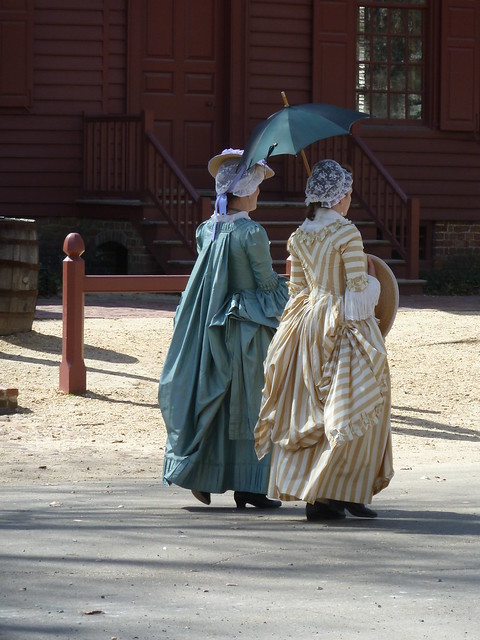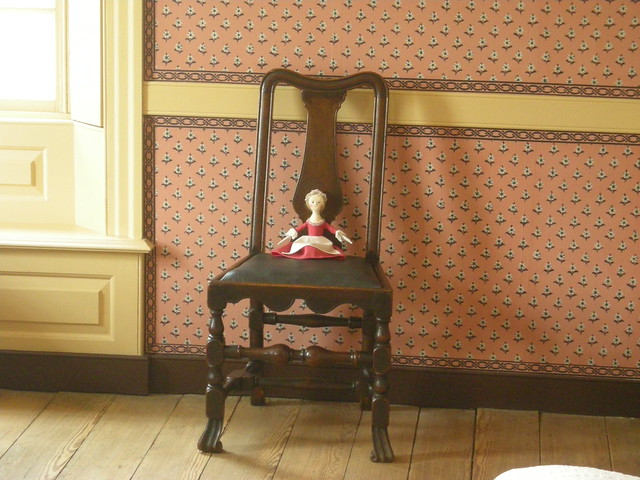Following lunch, the Case Studies session continued, reconvening with “The Hive: Creating a Buzz” presented by Stephanie Smith and Hallie Larkin (volunteers, Minuteman National Historical Park, Concord, Massachusetts). They relayed the inspiring story of creating a volunteer-run organization which provides workshops and events to aid reenactors in acquiring the most accurate clothing and accessories possible. Independent reenactors oftentimes are unsure of where to go for resources or simply don’t know where to start. The Hive uses a variety of primary sources (from extant garments to prints and paintings to runaway ads) and offers a fun, free, and friendly atmosphere where reenactors and volunteers are taught by example, not just told, how to portray accurately. They have offerings for men and women as well as children, and offer support for projects both small and large. They use their own experiences and even have a “dos and don’ts” fashion show where common clothing mistakes are highlighted in a jocular manner, so that no one will feel embarrassed about making the mistakes we've all made as beginners. Be sure to visit their website to read about their work and their upcoming workshops.
CW actor-interpreters strolling on Duke of Gloucester Street
In “What Are You Obsessing Over Now? Twenty Years of Clothing Continental Army Interpreters,” Michael S. McGurty (interpretative programs assistant, New Windsor Cantonment State Historic Site, Vails Gate, New York) told us about his trials in costuming living history sites, most specifically in persuading management to dedicate more time and resources to accurate clothing. One anecdote he shared described his elatation when at one point in his career, he actually achieved permission to procure a large amount of wool from an English supplier who dates back to the 18th century to recreate some new regimental coats for the museum staff. The shipment, however, was stopped by customs on its way into the country and ended up costing a great deal more than anticipated. But these, he said, are the necessary trials of this field, which is still worth it despite them all.
Following this was Lindsey Holmes (costumier, Past Productions Museum Theatre Company, London, England) who presented “Dress Sense: Costume as a Multisensory Historical Experience.” She described several of her recent projects which used clothing, either as the topic itself or as an accessory to the theatrical production, to engage the audience further into the stories. For example, for one museum-based performance, actors were stationed in rooms around a house as the audience moved from one room to the next. She noted how the sounds and movements of the costumes (going up the stairs, rustling as they walked, etc.) enhanced the characters and their portrayals and gave the audience a multisensory experience of what the sights and sounds of the period were actually like. Even the smell of the clothes, by washing or storing them in the manner of their time period, can greatly enhance the believability of a living history performance.
A doll on display at the George Wythe House, CW.
After another short coffee break, we heard “The Mythical Bodice and its Successors at Colonial Williamsburg,” presented by Claudia Brush Kidwell (curator emeritus, National Museum of American History, Washington, D.C.), Sally Queen (manager, CW Costume Design Center, 1987-1995), and Linda Smith (cutter-draper-patternmaker, CW Costume Design Center). This presentation and discussion was a lot of fun and is one of my favorites from the conference. I think we’ve all witnessed examples of how historical costume recreation has evolved over time, and this was just one example. The panel began by sharing one of their favorite slogans: ISLAGIATT ("it seemed like a good idea at the time"). They described how a few of the hostesses at CW began wearing costumes in 1934 as part of the special Garden Week. The public loved the idea and both visitors and management started asking for more. CW experimented with different styles and levels of clothing (even modern uniforms, which angered visitors!) over the years, until in preparation for bicentennial celebrations, they needed to construct many costumes quickly and at a low cost. Enter "the bodice," with no historical basis whatsoever, but it was quick and easy to make and, well, ISLAGIATT. By the 1980s, clothing accuracies were just beginning to be researched and discussed more widely; as knowledge was enhanced, the CDC decided to replace the bodices with historically documented short gowns. In order to fund this new project, however, CW sold the bodices to other historic sites, thus perpetuating the practice of wearing this "mythical" piece of clothing and passing it as one with historical basis. Through this presentation, these ladies called on us all to get the word out there: stop wearing them and teach the next generation about proper garments instead! The presenters also described some of the projects the CDC has pursued since that time which help portray an accurate sense of the time, and which also fit the needs of the employees, their physical work, and the agenda of the Foundation as a whole.
The afternoon ended with our keynote speaker, Richard Pickering (deputy executive director, Plimoth Plantation). His presentation, “Shifting Seam: Tailor Made History for the Next Generation,” began with the story of his first steps into history, thanks to a Miss Harris who noticed his interest and drew him in further by taking down the barriers and allowing him to witness history on an entirely new level. As practitioners of historical research and interpretation, it is our responsibility to train the next generation by opening their imaginations and inspiring them to ask questions and to encourage them to make inquiries. Mr. Pickering also told us about a project which placed a group of female college students into a full immersion experience at Plimoth Plantation. With only a few weeks of training, the students were literally left in the woods at night as interpreters led them to Plimoth and through a full reenactment of a documented scenario. They were reenacting the actual event of a ship, stuck on the rocks near Plimoth, which they needed to abandon in the middle of the night. As they walked through the woods, unaware that any settlement was nearby, they encountered some Native Americans who led them to Governor Bradford in Plimoth. The ladies were then dispersed as servants to the families in the settlement. Click here for a NY Times article about the project.
What a wonderful first day of the conference! So many stories and experiences shared and so many discussions opened. I am looking forward to seeing how some of these discussions progress and how they affect the use of costumes and the costuming practices of living history sites in the years to come.
But first, day two of the conference!



3 comments:
Love some of these stories!
Laurie
wow, didn't know my hair was that long! Thanks for posting the descriptions of each session. It was nice to 'see' it through your eyes. Sometimes we can sit in the same sessions and each of us hear what we want to hear.
Hi Kim! So glad you "found" us! Nothing wrong with long hair (you should see mine down...yikes), and besides, you need *something* to pin your cap to! How'd that "Shock and Despair (and not a little bit of jealousy)" picture of the $200 CDC curtain come out?! ;-)
Post a Comment